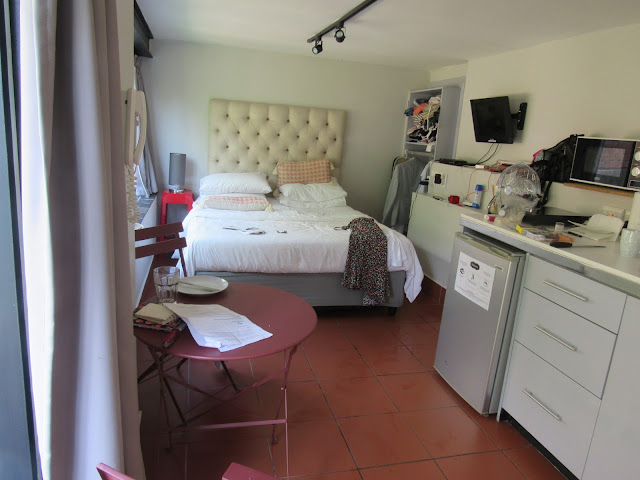Our place is the bottom flat beyond the wooden steps. This is at the back of the house, the upstairs of which is occupied by the owner of these and several other properties in Cape Town. It is very nice and well appointed but more studio than apartment. Look inside and you will see what I mean.
Not as tidy as Helen would have liked.
The pool is a bonus and I pretty well had sole use of it. It also features a device that I have not seen before. You have probably seen those robot vacuum machines that randomly wander around your floor and magically clean it. Well this is the aquatic equivalent. It's name is MX5, happy memories.
The area we are in, Devils Peak Estate in Vredehoek is prosperous, and largely white. There is nothing like the amount of home security here, compared with Pretoria. We do have a sliding front gate, which is operated by a key fob. The view from our front door is however rather impressive. Here it is.
It is, of course Table Mountain. The cable car up it starts about 1km away round to the right of where you are looking. The overriding concern is still Helen's health. Her problems continue unabated for the rest of Saturday and through the night. On Sunday morning I went to the 24 hour pharmacy at the airport. The chemist prescribed more imodium, a prebiotic with 5 separate strains and finally some rehydration drink sachets. Despite the new medicaments and the pharmacist's best reassurances there really is no improvement. On Monday about 7-30am we decide it is time for Cape Town Medi centre, that is the private hospital that has A and E facilities. The treatment was very good, a rather brusque nurse followed by a thorough examination by a young doctor. She took samples for testing and prescribed antibiotics, a different binder and some more dehydrating drinks. Well let's see what happens next. Helen had the first solid nights sleep, so to speak, for 6 nights. Tuesday, and we decided to try a gentle trip out to see how things go.
The famous clock tower on the Victoria and Alfred water front. Why Alfred and not Albert you ask. It was built in 1860 at the time of the Prince Consort's death and is named after her eldest son Alfred Edward. While we were there we booked for the trip to Robben Island, now a World Heritage Site which we will do on Thursday, all things being well.
This plan allows us to do the Red bus trip tomorrow which is a present from Cameron, Helen, Ollie and Finlay. After a spot of lunch we complete this first tentative day out with a drive down the Atlantic Ocean coast including the renowned Chapman's Peak Drive. On the way round we popped into Llandudno. Now someone got this wrong. Whoever named the place clearly had never been to the real Llandudno. I think they got it muddled up with somewhere in Cornwall. I suppose if you were a mono-ocular Welshman you might see the similarity between Table Mountain and the Great Orme.
Chapman's Bay.
Hout Bay looking north.
This wonderful silver beach behind Helen has hardly got a soul on it and stretches for nearly 5kms. It is called Noordhoek beach.






















































